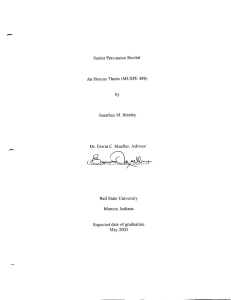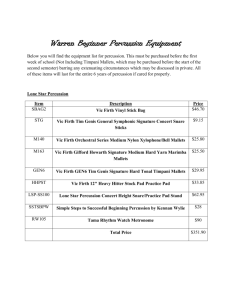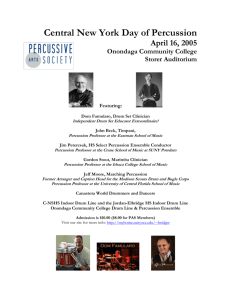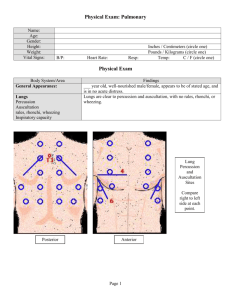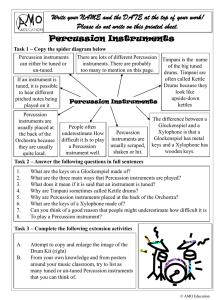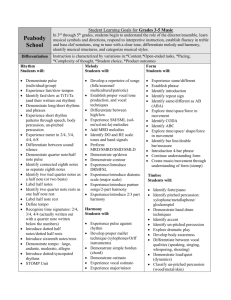Weather Report Heavy Weather* Alex Acuna
advertisement
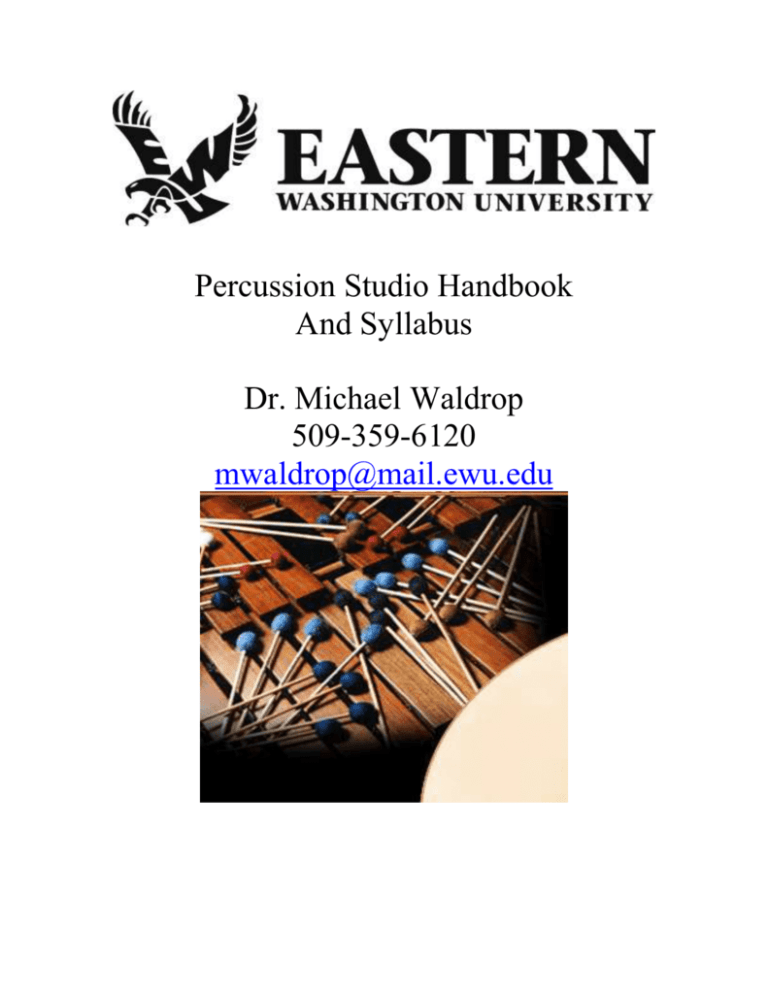
Percussion Studio Handbook And Syllabus Dr. Michael Waldrop 509-359-6120 mwaldrop@mail.ewu.edu Eastern Washington University Dr. Michael Waldrop 509-359-6120 Office 143 mwaldrop@mail.ewu.edu PERCUSSION APPLIED LESSONS HANDBOOK Lessons are divided into ten assignments, with the material of each level divided accordingly to assist individuals in pacing themselves throughout the semester. It is the responsibility of students to prepare material prior to their scheduled lesson time. The assignments are arranged to allow ample time for preparation. Students should give notice if they cannot attend a lessson. This can be done by making a phone call , placing a note on the door, or placing a note in the teacher’s box (in the music office). Failure to notify your instuctor can affect the final grade. Lessons missed by the student will not be made up unless excused by the instructor. Lessons missed by the instructor will be made up at a time convenient for both. The student will be allowed one absence; after that each absence lowers the final grade by a letter. The student is also responsible for Friday Convocation Hour Attendance and Performances. Everyone is required to perform at least once, except for those students who are studying percussion as a secondary instrument or who aren’t music majors. Failure to perform, as well as excessive absences (2-3) from Recital Hour, can affect the final grade. Additionally, students are also required to attend all student, guest artist and faculty percussion recitals in a given semester and to assist with equipment movement for these recitals. A list of percussion events will be posted during the semester which will list all required performances. Failure to attend and assist with equipment movement will result in the reduction of the student’s grade, at the teacher’s discretion. ESSENTIAL MATERIALS FOR THE PERCUSSION STUDENTi The student will need to have a number of different sizes of snare drum sticks ranging from light(7A), Medium( 5A, 3A) to Heavy(2B, 3S). The student will need a set of 4 matched medium soft marimba mallets. A pair of General size timpani mallets are also needed. Students focusing on drumset will need to have a set of cymbals(2 rides, a crash and hi-hats). The above listed materials are the bare minimum. Obviously a percussionist should work over a career to acquire as many different types of mallets and sticks as possible. However, the requirements listed above will suffice for the short term for the new student. The methods and solo repertoire listed below can be obtained at the area music stores. Music that is not at these two stores can be mail-ordered through various stores. An excellent source for both mallets/sticks and printed percussion music is Steve Weiss Music PH:215-659-0100. I have a number of catalogs for them, which I will be glad to loan you. Students should strongly consider joining the Percussive Arts Society. Emembership is 25$ for students. You can access the website and join at www2.pas.org. PRACTICE ROOMS The main percussion practice room is 143. There is the large 5 octace Adams marimba, a snare drum on a stand, a set of five timpani, vibraphone and xylophone. Adjacent to 143 is room 141A; this room is a drumset teaching studio and practice room. There is an alcove of five rooms reserved for percussion practice, they are assigned as follows: Room 136A is a drumset practice room with a student kit, Room 137B houses a 4 octave marimba, 137C is a room with an Roland RMP electronic practice pad and various auxiliary percussion instruments, 137D has a 4 &1/3 marimba, 137E holds a pair of 29” and 26 timpani. There is another room in the northwest alcove, Room 140D with a 4 1/3 marimba. Room 130 is a large practice room housing a drumset and a vibraphone. All rooms will have a schedule and students will be allowed to sign up and reserve an hour a day in each room. The student is encouraged to practice more than the assigned hour of course and you may sign up for an hour in every room. If the room is vacant then the student is welcome to practice outside of his/her assigned time. PURCHASING MUSIC Students are required to purchase the music and books as assigned by their applied professor. Copies of music are illegal and not acceptable. Failure to properly obtain assigned music will result in the reduction of the grade. Music on the syllabus can be obtained at local music stores and through ordering out of state from stores such as Steve Weiss Music and JW Pepper. SNARE PROFICIENCY Facility in snare drum playing is the foundation of good technique in the performance of virtually all Western percussion instruments: timpani, mallets, and drumset. Snare drum study is the time when the student can focus on stick control, articulation and execution of the four basic strokes (single, double, flam and buzz), sticking variations, reading, and finally and most importantly: the musical phrasing of rhythm. 1800 First Year Materials: Modern School for Snare Drum- Goldenberg, Haskell Harr Drum Method Volume 2, Stick Control- Stone 2800 Second Year Materials: Portraits in Rhythm- Cirone, The All-American Drummer- Wilcoxen, Modern Rudimental Swing Solos- Wilcoxen, Stick Control- Stone, 3800 Third Year Materials: Douze Etudes- Delecluse, Advanced Snare Drum StudiesPeters, 14 Modern Contest Solos- Pratt, Master Studies- Morello 4800 Fourth Year Materials: Three Dances- Warren Benson, Six Unaccompanied Solos- Colgrass, Rudimental Cookbook- Freytag, Pezzo Da Concerto- Zivkovic, The Noble Snare- ed. Stuart Smith (these are just a few examples of advanced solo material for snare drum that may be programmable for recital hour or senior recitals,) Orchestral Excerpts: Rimsky- Korsakov- Scheherazade and Cappricio Espagnol, Prokoviev- Lieutenant Kije, Ravel- Bolero, Nielsen- Symphony No. 5, BartokConcerto for Orchestra MALLET PROFICIENCY The study of mallet instruments is the percussionist’s link to melody and harmony. There are four main instruments in the mallet family: Marimba, Vibraphone, Xylophone, and Bells. The main instrument students will focus on will be the marimba because of it’s extended range. The vibraphone will also be addressed with its additional difficulties relating to dampening and pedaling techniques. The coverage of xylophone and bells will be limited mainly to orchestral excerpts. 1800 First Year Materials: Fundamental Method for Mallets Vol. I - Peters, Grover Transcriptions- Grover, chorales and miscellaneous repertoire 2800 Second Year Materials: Fundamental Method for Mallets Vol. 2, Vibraphone techniques, lead sheet realization, Intermediate solo literature for marimba (some pieces listed below under solo literature), Bach Chorales- arr. Waldrop, Sonatas and PartitasBach, Sonatas for Cello- Bach 3800 Third Year Materials: Solo literature(see attached list) for marimba and vibraphone, excerpts, and jazz improvisation. 4800 Solo Literature: Intermediate: Teardrops, Yellow After the Rain, Waves - Mitchell Peters Raindance, Gitano- Alice Gomez, Monograph IV- Gipson, Etudes Op. 6- Musser, Concertino- Creston, Funny Mallets I and II Zivkovic, Contemporary Solos and Etudes- Karen Ervin, Preludes for Marimba- Rosauro Advanced: Works for Marimba- Keiko Abe, Two Mexican Dances- Stout, Marimbetudes, Four Movements for Marimba- Burritt, Time- Miki, Two Movements- Tanaka, Concerto for Marimba- Rosauro, Rhythm Song- Smadbeck, Grand Fantasy- Helble, Dream of the Cherry Blossoms- Abe, Drei Fantastiche Lieder- Zivkovic The above listed works are merely a few well-chosen suggestions; marimba repertoire is now vast and rich in quality. Students are invited to choose their own repertoire from this list or from outside the list provided the chosen pieces meet the instructor’s approval. Orchestral Excerpts: Xylophone: Porgy and Bess- Gershwin, Colas Breugnon- Kabalevsky, Appalachian Spring- Copland, Golden Age Polka- Shostakovich Bells: Sorcerer’s Apprentice- Dukas, Pines of Rome- Respighi, La Mer- Debussy TIMPANI PROFICIENCY Timpani is unique among percussion instruments in that it is the only membranaphone with definite pitch. Timpani playing requires a more legato stroke than in snare drum playing. The grip used is generally French grip with the palms facing each other and the thumbs facing up. Perhaps the most challenging aspect of timpani playing is intonation or tuning. Proficiency in timpani playing is inextricably linked to the development of the ear. Skill in solfege is essential. Because of these additional demands timpani study begins in the second year of percussion study, after basic ear training, keyboard and snare drum skills are attained. The skills gained by playing multiple drums also transfers to drumset playing. Materials: The timpanist should ultimately have at least 3 pairs of mallets: soft, medium, and hard(staccato). 2800 Second Year Materials: Fundamental Method for Timpani- Mitchell Peters, Etuden fur Timpani- Richard Hochrainer 3800 Third Year Materials Timpani Tuning Etudes- Ron Fink, 32 Solos- Al Lepak 4800 Solo Literature: 8 Pieces for Timpani- Elliot Carter, Raga No. 1- William Cahn, 3 Etudes for 5 Timpani, 4 Verses, 3 Settings- Houliff (this is just a sampling) Orchestral Excerpts: Symphonies 5, 7 and 9- Beethoven, Sym. 4- Tchaikovsky, Symphonie FantastiqueBerlioz, The Rite of Spring- Stravinsky, Symphonic Metamorphosis- Hindemith DRUMSET PROFICIENCY Every percussionist should have at least basic proficiency in drumset. Orchestral and classical percussionists are often required to play some drumset in pops type concerts and contemporary music often requires the percussionist to use his feet playing pedal percussion instruments such as hi-hat and bass drum. Those percussionists who aspire to a career in jazz will obviously need to acquire a highly developed proficiency on the drumset. The following three year program of study is recommended for those percussionists who wish to focus on jazz and the drumset. For those percussionists who do not intend to focus on jazz the first year of this program will be sufficient. The drumset is the highest evolution of western percussion. Mastery of the instrument requires intensive study, development of independence, memorization of style patterns, and development of improvisational sensibilities. The use of the feet to such a high degree is unique in the percussion world. No other percussion instrument in the world necessitates such an evolved usage of the feet in its playing techniques. 1800 First Year Materials: Basic Independence Exercises in Jazz and Rock Styles(excerpted from Erskine’s Drum Concepts), Creative Coordination- Keith Copeland, Essential Styles- Houghton, Studio and Big Band Drumming- Houghton, Groove Pamphlet- Waldrop, Bop DrummingRiley, Foot Ostinatos- Waldrop 2800 Second Year Materials: A continuation of the above materials with the intent of finishing them. Two new materials will be introduced: Future Sounds- Garibaldi (or Advanced Funk Studies- Rick Latham), Beyond Bop Drumming- Riley, Solo Transcriptions Introduction of Song Form playing- The student will begin to a acquire a memorized repertoire(see below) of jazz standards which he will be able to realize and improvise over on the drumset. 3800 Third Year Materials: Continuation of the above materials with the goal of finishing them before the year is out. The student will continue working on preparing transcribed solos from the three volumes of North Texas Drumset Transcripitions, Steve Gadd Up Close, and from the other publications by the Drummers Collective. He or she will also transcribe and notate two solos from a recorded source in consultation with the professor. 4800 Fourth Year Materials: Hi- Hat Integration- Jan Prins, Recital Preparation Initial Repertoire for Song Form Playing: Blues Tunes: C Jam Blues, Sonnymoon for Two, Billies Bounce, Blue Monk, Mr PC, Tenor Madness, Blues Walk, Now is the Time, Straight No Chaser, 32 bar AABA Tunes: I Got Rhythm, Salt Peanuts, Oleo, Rhythm-a-Ning, Seven Steps to Heaven, Scrapple from the Apple, Confirmation Miscellaneous forms and styles: Doxy, St. Thomas, Blue Bossa, Someday My Prince Will Come PERCUSSION ARTISTS TO BE AWARE OF AND TO LISTEN TO: Here is a brief list of some of the various percussionists in many different fields you need to know about and listen. It is imperative that you know what the standards are for excellence in percussion performance and who sets these standards. Classical Percussion/Marimba: Evelyn Glennie-Marimba and Percussion(many CD’s available) Nebojsa Zivkovic- Marimba and Percussion(Castle of the Mad King, Uneven Souls) Gordon Stout- Marimba(2 CD’s) Leigh Howard Stevens- Marimba(2 CDs) She e Wu- marimba Anthony Cirone-orchestral percussion Jonathan Haas-timpani Keiko Abe-marimba Steve Schick-percussionist Ney Rosauro-marimba/percussion Jazz Vibraphone: Gary Burton Arthur Lipner Dave Samuels Lionel Hampton Dave Friedmann Milt Jackson Bobby Hutcherson Drumset Artists: Steve Gadd Dave Weckl Steve Smith Kenny Aronoff Vinnie Colaiuta Steve Houghton Max Roach Louis Bellson John Riley Peter Erskine Jack DeJohnette Elvin Jones Art Blakey Buddy Rich Keith Copeland Manu Katche Alex Acuna Dennis Chambers Omar Hakim Jeff Hamilton Greg Bissonette Greg Field Dennis Mackrel Mike Portnoy Danny Carey Josh Freese Phil Collins JoJo Mayer Latin Percussion: Pancho Sanchez Giovanni Hidalgo Tito Puente Luis Conte Alex Acuna Manolo Badrena Nano Vasconcelos World Music/Percussion: Glen Velez Zakir Hussein Jamey Haddad Essential Discography for the Drumset Student This is a brief compilation of some of the most important records ever recorded(also included are some excellent compilations which give a nice overview of an important artist’s ouevre. The student should listen extensively to these albums in order to assimilate style and learn about the great music and drummers that have shaped musical style. Each album is listed by Style, Artist, Title and Drummer. Albums that are marked in bold* with asterisk are absolute musts! Small Group Jazz: Miles Davis Miles Davis Kind of Blue* Milestones Jimmy Cobb Philly Joe Jones Miles Davis Art Blakey & The Jazz Messengers Clifford Brown and Max Roach “ Sonny Rollins Sonny Rollins John Coltrane “ “ McCoy Tyner Elvin Jones Chick Corea Roy Haynes Keith Jarrett Chick Corea Bill Evans Peter Erskine Trio Wynton Marsalis Herbie Hancock Four and More*, Nefertiti* Tony Williams Best of (Blue Note)* Art Blakey …………………… Max Roach Study in Brown* Max Roach Saxophone Colossus Max Roach Ken Burns Jazz Max, Elvin, et al Live at Birdland* Elvin Jones A Love Supreme* “ Ken Burns Compilation Elvin Jones et al The Real McCoy* Elvin Jones Live at the Lighthouse Elvin Jones Friends*; Three Quartets Steve Gadd We Three Roy Haynes Standards 1,2 and Live* Jack DeJohnette Now He Sings, Now He Sobs Roy Haynes Live at the Village Vanguard Paul Motian You Never Know, As It Is Peter Erskine Standards Vol. 1 Jeff Watts Best of Blue Note Billy Higgins Tony Williams Big Band Albums: Count Basie Atomic Basie Sonny Payne Count Basie Straight Ahead Rufus Jones Dianne Schurr….. and the Count Basie Orchestra* Dennis Mackrel Thad Jones/Mel Lewis Consummation* Mel Lewis Buddy Rich Best of ..the Pacific Jazz Years* Buddy Rich Duke Ellington Ken Burns Jazz Collection* Sonny Greer et al (this is an excellent compilation/overview of Dukes ouevre) Bob Mintzer Urban Contours Peter Erskine Bob Mintzer Incredible Journey Peter Erskine Bob Mintzer Art of the Big Band Peter Erskine Bob Mintzer The First Decade Peter Erskine (this album is a best of compilation of the first 3 titles and other albums) Gregg Field The Art of Swing Gregg Field Woody Herman Giant Steps Ed Soph Patrick Williams Sinatraland* Peter Erskine UNT 1 O’Clock Band Lab 75 Steve Houghton Bob Curnow(with the WDR) Music of Pat Metheny and Lyle Mays Paquito D’Rivera(with the WDR) Big Band Time Mark Walker Electric Jazz: Funk and Fusion(some pop music) Weather Report Weather Report Weather Report Herbie Hancock Heavy Weather* 8:30 Domino Theory Head Hunters* Alex Acuna Peter Erskine Omar Hakim Harvey Mason Herbie Hancock Miles Davis Thrust Bitches Brew* Miles Davis Mahavishnu Orchestra Tower of Power Tower of Power Chick Corea/RTF Chick Corea Chick Corea Pat Metheny Amandla, Tutu Inner Mounting Flame self titled What is Hip-Anthology Where Have I Known You Before Return to Forever Light as a Feather* Still Life, Letter From Home* Imaginary Day etc. Pat Metheny Pat Metheny Group Peter Gabriel So* Jan Garbarek Visible World Steely Dan Aja* Sting Ten Summoners Tales Frank Zappa Joe’s Garage Stax: Otis Redding, Al Green etc……….. Motown: Marvin Gaye, Supremes, etc………. Mike Clark DeJohnette Lenny White Ricky Wellman Billy Cobham David Garibaldi David Garibaldi Lenny White Airto Moreira Airto Moreira Paul Wertico Dan Gottlieb Manu Katche Manu Katche Steve Gadd et al Vinnie Colaiuta Vinnie Colaiuta Al Jackson Benny Benjamin Latin: Cuban and Brazilian Cuban: Los Van Van Songo, Que Pista Changuito(congas) (any CD is good, there are a couple of best of compilations also excellent) Tito Puente Dance Mania Tito(timbales)Mongo Santamaria(congas) Tito Puente Puente Goes Jazz* “ Tito Puente Best of (Rhino)* nice compilation “ Mongo Santamaria Best of , Afro Roots* Santamaria(congas) Eddie Palmeiri Mambo con Conga es Mozambique ………………… Ray Baretto Handprints*, Que Viva la Musica Baretto(congas) Ed Uribe(drums) Cal Tjader Soul Sauce,..Plays Mambo Tjader(vibes) et al Carribean Jazz Project………….. Dave Samuels(vibes) Paquito D’Rivera Havana Café Sandoval, D’Rivera Reunion Michel Camilo On Fire Joel Rosenblatt Batucumbele Con un Poco de Songo Mario Bauza Mambo Kings Play Songs of Love various (soundtrack recording) Paquito D’Rivera Big Band Time Mark Walker Alex Acuna Acuarela de Tambores Acuna, Giovanni Hidalgo, Luis Conte Poncho Sanchez Soul of the Conga, Latin Soul* Brazilian: Airto Moreira The Essential Airto…. “ The Colours of Life (also see the Chick Corea albums listed above in fusion) Milton Nascimento Miltons Getz Jazz Samba* Getz/Gilberto The Girl from Ipanema* Francis Albert Sinatra and Antonio Carlos Jobim*…….. Eliane Elias Plays Jobim* Eliane Elias Three Americas, Fantasia Eliane Elias Long Story Nana Vasconcelos Saudades, Storytelling Ivan Lins Viva Sonhando/Triste Sanchez, Tony Banda Airto “ Dom Um Romao etc Jack DeJohnette Erskine et al Dave Weckl Nana(percussion)
